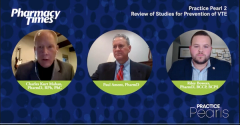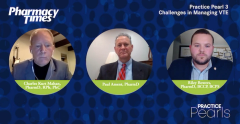
Practice Pearl 3: Challenges in Managing VTE
Panelists review the challenges in managing VTE.
Episodes in this series

Charles Kurt Mahan, PharmD, RPh, PhC: Our last brief topic is this: The 2 of you can discuss some of the challenges remaining in managing VTE [venous thromboembolism], some of the complications of recurrent VTE, and some of the challenges with DOACs [direct oral anticoagulants]. You can touch on that briefly, please.
Riley Bowers, PharmD, BCCP, BCPS: One of the biggest challenges in managing VTE in general is education and keeping up with the newest literature. An example that I would come back to is the 2016 ISTH [International Society on Thrombosis and Haemostasis] recommendations on avoiding DOACs in the morbidly obese population, which has been disproved, at least with rivaroxaban.
Another challenge I find is managing and evaluating the risks. We talked a lot about this today, but with no gold standard risk-assessment model, there’s a clear need for additional research and guidance, especially as organizations such as ISTH and ASH [American Society of Hematology] want to make a push for risk assessment to be implemented at institutional levels. If we can get better at assessing and managing risk, we will eventually get better at appropriately covering patients with the correct pharmacotherapy. That’s where a lot of the challenges remain in managing VTE.
Paul Ament, PharmD: To add to the great points that Riley made, I find that the challenge is duration of therapy. When it’s a provoked VTE, that’s a pretty clear-cut 3 months, but in unprovoked VTE patients, how long do you continue therapy, especially if it’s a pulmonary embolus? If it’s a saddle embolus that requires thrombolysis, that puts me into a whole other category of long-term anticoagulation as well.
We now have the EINSTEIN-Extension study with rivaroxaban showing that a dosage of 10 mg once daily after you’ve been on at least 6 to 12 months of therapy has a bleeding risk no greater than a baby aspirin a day, yet it lowers the recurrence rate by about 75%. This makes us start to consider longer-term anticoagulation, especially in the patient who has an unprovoked clot.
Riley Bowers, PharmD, BCCP, BCPS: Absolutely. That’s a great point. One of the things we didn’t get into today was that secondary prevention use for the DOACs, and that goes back to the education piece about keeping up with all the different indications and doses where we can apply these DOACs instead of treating the VTE to manage those risks and lower rates of recurrence.
Charles Kurt Mahan, PharmD, RPh, PhC: These are great points. You can look up the EINSTEIN choice data if you’d like to.
With that, I wanted to thank Dr Ament and Dr Bowers. It’s great working with experts. Hopefully in the future when this coronavirus pandemic is over, we’ll be able to meet in person for a similar panel and discuss some other topics. I want to thank Pharmacy Times® for arranging this and coordinating it and also thank our viewing audience. We hope you found this Pharmacy Times® Practice Pearls® program to be rich and informative and that you had some good takeaways. Thank you.
Newsletter
Stay informed on drug updates, treatment guidelines, and pharmacy practice trends—subscribe to Pharmacy Times for weekly clinical insights.


















